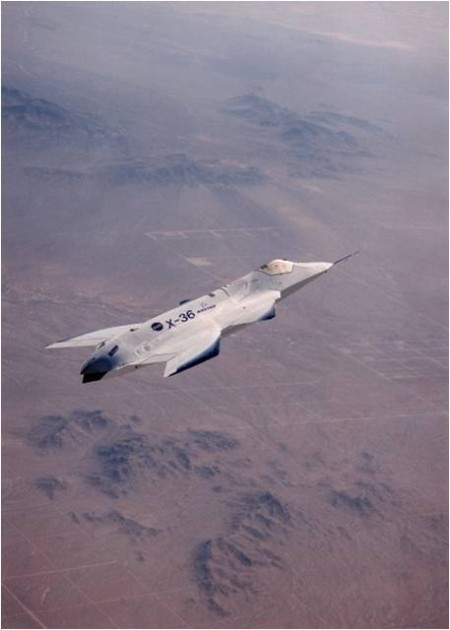Fifteen-years ago today, the NASA/Boeing X-36 Tailless Fighter Agility Research Aircraft (TFARA) flew its final research mission from the NASA Dryden Flight Research Center (DFRC) at Edwards, California. The remotely piloted vehicle was designed to demonstrate flight control technologies aimed at improving the maneuverability and survivability of future fighter aircraft.
The X-36 was a 0.28-scale version of a notional advanced fighter aircraft. It measured 19 feet in length and had a wingspan of approximately 10 feet. Gross Take-Off Weight (GTOW) was on the order of 1,250 lbs. Power was provided by a Williams International F112 turbofan engine generating a maximum thrust of 700 lbs.
The X-36 did not have a conventional vertical tail and rudder assembly. Rather, the type utilized a unique set of aero-propulsive flight controls that included dual canards, split ailerons and a vectorable nozzle for aircraft directional control. Since the X-36 was longitudinally and directionally unstable, 3-axis flight control was provided via a digital fly-by-wire flight control system.
Boeing manufactured a pair of X-36 airframes. (A review of the historical record indicates that neither vehicle was officially assigned an airframe serial number.) The X-36 was remotely-controlled by a pilot sitting within a virtual cockpit at a ground station. A real-time video feed from a nose-mounted camera aboard the aircraft was transmitted to provide visual information to the pilot. A typical research flight from take-off to landing lasted between 35 to 45 minutes.
The X-36 flight research program began on Saturday, 17 May 1997 at Edwards Air Force Base, California. The last of 31 very successful research flights was flown on Wednesday, 12 November 1997. During this 6-month period, the aircraft amassed a total of 15 hours and 38 minutes of flight time. Peak performance marks included an altitude of 20,200 feet, speed in excess of 230 mph and a maximum angle-of-attack of 40 degrees.
The X-36 was both highly maneuverable, agile and controllable. The aircraft also served as a versatile testbed for testing innovative control law software. Flight testing of the X-36 aircraft measurably improved our understanding of the aerodynamic and flight control characteristics of futuristic aircraft configurations. In short, the X-36 Program was a very well conceived and executed flight test effort.
Happily, both X-36 aircraft survived the flight test program. One of these ships can be seen at the National Museum of the United States Air Force in Dayton, Ohio. The other aircraft is displayed in the Air Force Test Flight Center Museum at Edwards Air Force Base, California.


